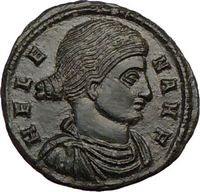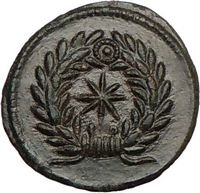Saint Helena Roman Empress Mother of Constantine the Great Biography
Ancient Roman Coins for Sale for Collecting or Investing
You can buy certified authentic ancient Roman coins of
saint Helena for sale here.


Example of Authentic Ancient
Coin of:
Helena 'known as Saint Helena'- Mother of
Constantine the Great -
Bronze Follis Thessalonica mint: 318-319 A.D.
Reference: RIC VII 50; Kent-Hirmer pl. 162, 637; LRBC 821
Pedigree: Ex Gorny & Mosch
HELENA N F, draped bust right.
Eight-pointed star in laurel wreath.
Flavia Julia Helena, the mother of Constantine the
Great, was born in 248 AD and began her career as a barmaid in Naissus
(Moesia). She became teh mistress, and possibly wife, of Flavius
Constantius before his elevation to the rank of Caesar and bore him a
son, Constantinus (Constantine the Great) about 272/3. On Constantius'
appointment as Caesar in 293 he was obliged to repudiate Helena in favor
of Theodora, stepdaughter of the western Augustus Maximian. Helena
followed her son's example in converting to Christianity after the
victory over Maxentius in 312 and became very active in promoting the
interests of Church. Her elevation to the rank of Augusta did not take
place until 324 in connection with the celebration of Constantine's
victory over his rival, Licinius, which gave him control of the whole
Empire. Two years later Helena seems to have played a key role in
revealing the treachery of her daughter-in-law, the empress Fausta, in
the affair of Crispus Caesar's disgrace and execution. Fausta herself
was put to death after which Helena left Rome on a pilgrimage to the
Holy Land. She died on her return to the West in 329 AD and was later
canonized. Her festival is still celebrated in the Greek Orthodox
Church.
The coinage of Helena as Augusta commenced with her elevation to full
imperial status in 324 and continued until her death five years later.
Preceding these issues, however was a remarkable series struck circa 318
AD at the Thessalonica mint on which both Helena and her daughter-in-law
Fausta are accorded the lesser title of Nobilissima Femina (N F). Both
ladies had borne this rank for come considerable time, Helena since her
son's elevation to imperial status in 306, Fausta since her marriage to
Constantine in March of the following year. The significance of the
anepigraphic reverse with star within wreath remains unexplained, though
presumable it contains reference to divine providence and destiny.
Saint Helena (Latin:
Flavia Iulia Helena Augusta)
also known as Saint Helen, Helena Augusta or Helena of
Constantinople (ca. 246/50 18 August 330) was the consort
of
Emperor
Constantius, and the mother of Emperor
Constantine I. She is traditionally
credited with finding the
relics of the
True Cross.
Family
life
Helena's birthplace is not known with certainty. The sixth-century
historian
Procopius is the earliest authority for
the statement that Helena was a native of
Drepanum, in the province of
Bithynia in
Asia Minor. Her son Constantine renamed
the city "Helenopolis"
after her death in 328, giving rise to the belief that the city was her
birthplace. Although he might have done so in honor of her birthplace,
Constantine probably had other reasons for doing so. The Byzantinist
Cyril Mango has argued that Helenopolis
was refounded to strengthen the communication network around his new
capital in Constantinople, and was renamed to honor Helena, not to mark
her birthplace. There is another Helenopolis, in Palestine, but its
exact location is unknown. This city, and the province of
Helenopontus in the
Diocese of Pontus, were probably both
named after Constantine's mother.
The bishop and historian
Eusebius of Caesarea states that she
was about 80 on her return from Palestine. Since that journey has been
dated to 32628, Helena was probably born in 248 or 250. Little is known
of her early life. Fourth-century sources, following
Eutropius' "Breviarium," record
that she came from a low background.
Saint Ambrose was the first to call her
a stabularia, a term translated as "stable-maid" or "inn-keeper".
He makes this fact a virtue, calling Helena a bona stabularia, a
"good stable-maid". Other sources, especially those written after
Constantine's proclamation as emperor, gloss over or ignore her
background.
It is unknown where she first met
Constantius. The historian
Timothy Barnes has suggested that
Constantius, while serving under Emperor
Aurelian, could have met her while
stationed in Asia Minor for the campaign against
Zenobia. Barnes calls attention to an
epitaph at Nicomedia of one of Aurelian's protectors, which could
indicate the emperor's presence in the Bithynian region soon after 270.
The precise legal nature of the relationship between Helena and
Constantius is also unknown. The sources are equivocal on the point,
sometimes calling Helena Constantius' "wife", and sometimes calling her
his "concubine".
Jerome, perhaps confused by the vague
terminology of his own sources, manages to do both. Some scholars, such
as the historian Jan Drijvers, assert that Constantius and Helena were
joined in a
common-law marriage, a cohabitation
recognized in fact but not in law. Others, like Timothy Barnes, assert
that Constantius and Helena were joined in an official marriage, on the
grounds that the sources claiming an official marriage are more
reliable.
Helena gave birth to the future emperor
Constantine I on the 27th of February
of an uncertain year soon after 270 (probably around 272). At the time,
she was in
Naissus (Ni,
Serbia). Constantius divorced Helena at
some time before 289, when he married
Theodora, Maximian's daughter. (The
narrative sources date the marriage to 293, but the
Latin panegyric of 289 refers to the
couple as already married.) Helena never remarried and lived for a while
in obscurity, though close to her only son, who had a deep regard and
affection for her.
Constantine was proclaimed
Augustus of the
Roman Empire in 306 by Constantius'
troops after the latter had died, and following his elevation his mother
was brought back to the public life and the imperial court. She received
the title of
Augusta in 325 and died in 330 with
her son at her side. Her
sarcophagus is on display in the
Pio-Clementine Vatican Museum, although
the connection is often questioned. The elaborate reliefs contain
hunting scenes. During her life, she gave many presents to the poor,
released prisoners and mingled with the ordinary worshipers in modest
attire.
Sainthood
She is considered by the
Eastern Orthodox,
Oriental Orthodox and
Roman Catholic churches as a
saint, famed for her piety. Her feast
day as a saint of the Orthodox Christian Church is celebrated with her
son on 21 May, the "Feast of the Holy Great Sovereigns Constantine
and Helen, Equal to the Apostles." Her feast day in the Roman
Catholic Church falls on 18 August. Her feast day in the
Coptic Orthodox Church is on
9 Pashons.
Eusebius records the details of her
pilgrimage to
Palestine and other eastern provinces
(though not her discovery of the True Cross). She is the
patron saint of
new discoveries.
Relic
discoveries
Constantine appointed his mother Helen as
Augusta, and gave her unlimited access
to the imperial treasury in order to locate the relics of
Judeo-Christian tradition. In 325,
Helena was in charge of such a journey to
Jerusalem by her son. Upon the request
of the monks in the region, Helena ordered the construction of a church
in Egypt to identify the
Burning Bush of Sinai. The chapel, at
St. Catherine's Monastery often
referred to as the Chapel of Saint Helen, is dated to the year AD 330.
Jerusalem was still rebuilding from the destruction of Emperor
Hadrian, who had built a temple to
Venus over the site of
Jesus's tomb near
Calvary. According to legend, Helena
entered the temple with Bishop
Macarius, ordered the temple torn down
and chose a site to begin excavating, which led to the recovery of three
different crosses. Refused to be swayed by anything but solid proof, the
empress had a woman from Jerusalem, who was already at the point of
death from a certain disease, brought to her. When the woman touched the
first and second crosses, her condition did not change, but when she
touched the third and final cross she suddenly recovered[citation
needed], and Helena declared the cross with which
the woman had been touched to be the
True Cross. On the site of discovery,
Constantine built the
Church of the Holy Sepulchre as well as
on other sites detected by Helena.
She also found the nails of the crucifixion. To use their miraculous
power to aid her son, Helena allegedly had one placed in Constantine's
helmet, and another in the bridle of his horse. Helena left Jerusalem
and the eastern provinces in 327 to return to Rome, bringing with her
large parts of the True Cross and other relics, which were then stored
in her palace's private chapel, where they can be still seen today. Her
palace was later converted into the church
Santa Croce in Gerusalemme.
According to one tradition, Helena acquired the
Holy Tunic on her trip to Jerusalem and
sent it to
Trier.
Several of Saint Helena's treasures are now in Cyprus, where she
spent some time. Some of them are a part of Jesus Christ's tunic, pieces
of the holy cross and the world's only pieces of the rope to which Jesus
was tied with on the Cross. The latter has been held at the Staurovouni
monastery, which was also founded by Saint Helena.
A
Cathedral was named after her in
Helena, Montana.
Depictions
in British folklore
In
Great Britain, later legend, mentioned
by
Henry of Huntingdon but made popular by
Geoffrey of Monmouth, claimed that
Helena was a daughter of the King of
Britain,
Cole of
Camulodunum, who allied with
Constantius to avoid more war between the Britons and
Rome. Geoffrey further states that she
was brought up in the manner of a queen, as she had no brothers to
inherit the throne of Britain. The source for this may have been
Sozomen's
Historia Ecclesiastica, which
however does not claim Helena was British but only that her son
Constantine picked up his Christianity there. Constantine was with his
father when he died in
Eboracum (York),
but neither had spent much time in Britain. There is no other surviving
evidence to support this legend, which may be due to confusion with
Saint Elen, wife of the usurper
Magnus Maximus.
At least twenty-five
holy wells currently exist in the
United Kingdom that are dedicated to
Saint Helena. She is also the patron saint of
Colchester and
Abingdon.
Adrian Gilbert has argued that Helena
traveled to
Nevern in
Wales where she hid the
True Cross. near the local Norman
church of St Brynach, where a cross is carved into a rock formation.
Named the Pilgrim's Cross, religious pilgrims once came here to pray for
visions. Names of local places are abundant with cross imagery,
including "River of the Empress," "Mountain of the Cross," "Pass of the
Cross" and others. The
True Cross, however, has not been found
in this region.
Depictions
in fiction
Helena is the protagonist of
Evelyn Waugh's novel
Helena. She is also the main
character of
Priestess of Avalon (2000), a
fantasy novel by
Marion Zimmer Bradley and
Diana L. Paxson. She is given the name
Eilan and depicted as a trained
priestess of
Avalon. In the
anime and
manga,
Hellsing, the Nail of Helena is a
powerful artifact used by the Paladin Alexander Anderson to gain
supernatural power.
|